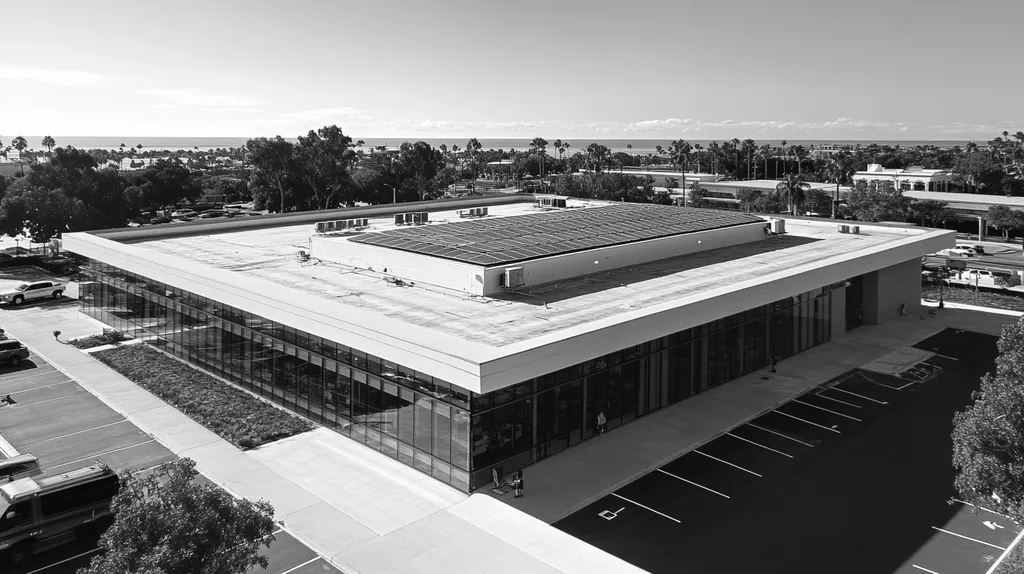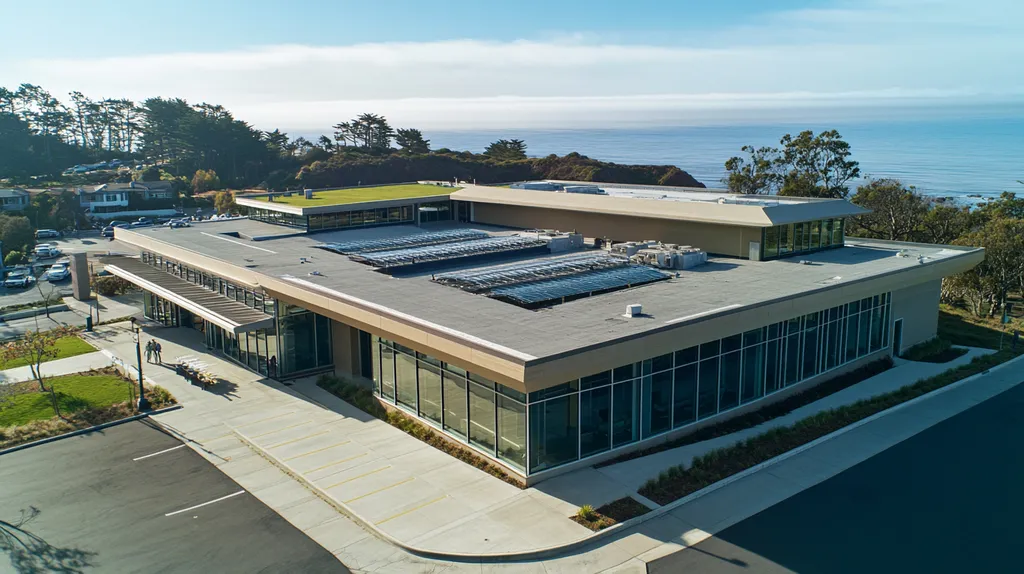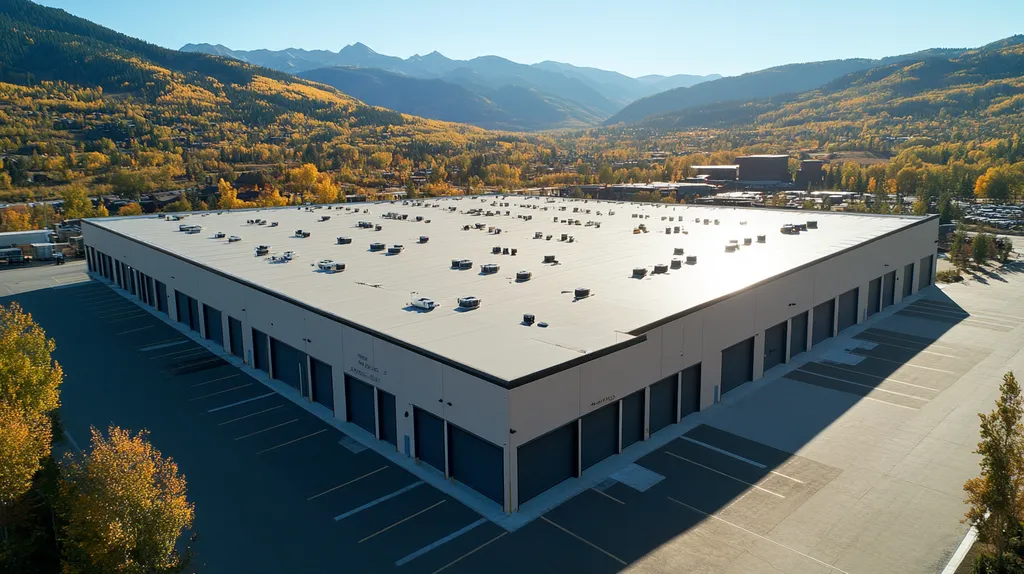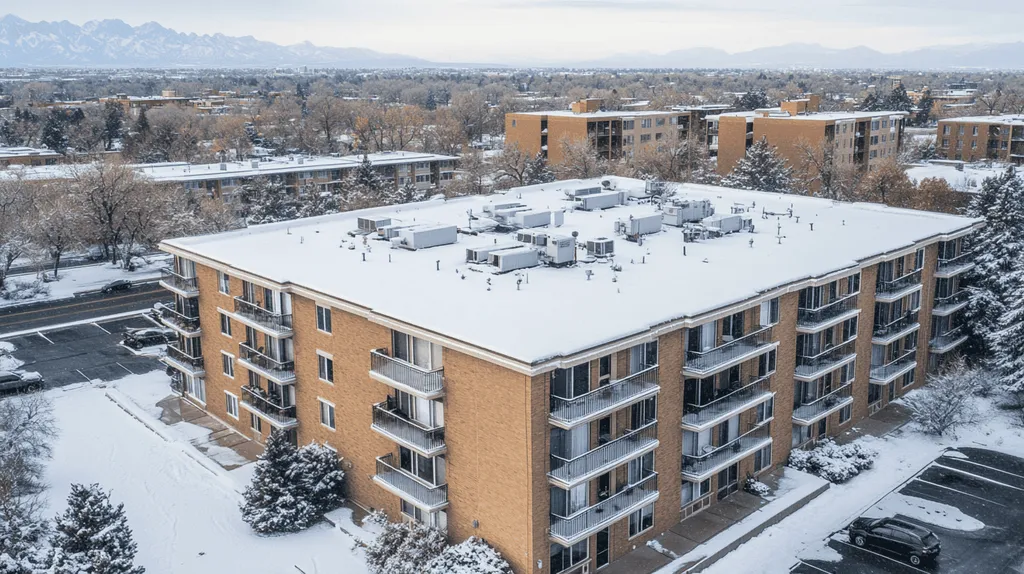Installation errors account for over 40% of commercial roof failures, leading to millions in repair costs and business disruptions annually across North America.
The difference between proper and improper installation techniques can slash a roof’s functional lifespan by half, turning a 30-year roof system into a 15-year liability.
Understanding core installation principles empowers property owners and facility managers to make informed decisions that significantly impact their building’s protection, energy efficiency, and long-term maintenance costs.
This comprehensive guide examines critical installation techniques, common pitfalls, and evidence-based strategies for maximizing commercial roof performance through proper installation practices.
SECTION 1: THE BASICS EXPLAINED
Understanding proper installation techniques is vital for maximizing the lifespan of a commercial roof. A poorly installed roof can set the stage for premature failure, leading to costly repairs or even complete replacements. Alarmingly, over 40% of commercial roof failures are attributed to installation errors. By grasping the core principles behind roof installation, property owners can make informed decisions that not only enhance roof performance but also extend its longevity.
What It Is (In Plain Language)
Commercial roofing installation consists of specific techniques designed to protect buildings from various weather elements. This includes methods such as membrane application, fastening systems, and the use of sealants. Each step in the installation process is crucial for creating a watertight seal and preserving the roof’s structural integrity.
A thorough installation process requires careful preparation of the roof deck, precise alignment of roofing materials, and effective sealing of seams. Overlooking these foundational steps can create vulnerabilities to leaks and structural damage as time goes on.
Moreover, selecting the right materials tailored to the local climate is equally important. Both the durability of the roofing materials and the installation techniques must work together to optimize a roof’s efficiency. For example, choosing the appropriate adhesive for a single-ply membrane can significantly enhance water resistance, making quality installation methods a wise investment for the long run.
Why It Matters (To Your Building)
The installation quality of a commercial roof significantly influences its overall performance and lifespan. A well-installed roof not only shields a building from leaks but also boosts energy efficiency. In contrast, inadequate installation can lead to severe repercussions, including structural damage and hefty repair bills.
Research shows that roofs with poor installation often fail within 10-15 years, whereas well-installed roofs typically last 20-30 years. This disparity can escalate operational costs and disrupt business activities considerably.
Furthermore, an underperforming roof can result in inflated energy bills, as ineffective insulation and sealing hinder temperature control within the building. By employing proper installation techniques, property owners can mitigate these issues and promote overall energy efficiency.
Ultimately, recognizing the importance of sound installation practices enables facility managers to prioritize roofing projects and allocate resources efficiently, ensuring that their structures remain safe, functional, and cost-effective over time.
How It Works
The mechanics of roof installation center on systematically applying materials and methods to withstand environmental challenges. For instance, the choice between mechanical fastening and adhesive bonding can profoundly affect the roof’s ability to endure wind uplift.
A detailed installation procedure accounts for every aspect, starting with selecting materials that complement the roof’s design. Different roofing systems, such as TPO or EPDM, rely on tailored installation techniques to optimize their unique characteristics.
Regular inspections during installation play a pivotal role in identifying issues before they escalate. Ensuring that the roof deck is clean and dry prior to installation can help avoid complications related to moisture and adhesion failures.
Finally, adherence to manufacturer guidelines and industry best practices is essential for achieving a high-quality installation. Consistently applying these methods results in a durable roofing system that stands the test of time and provides reliable protection against the elements.
SECTION 2: PRACTICAL APPLICATIONS
Recognizing the real-world implications of effective installation techniques is essential for extending the life of a commercial roof. Research indicates that subpar installation can sharply reduce a roof’s lifespan, resulting in expensive repairs and potential damage to the building itself. Property owners and facility managers must identify key installation elements that can either improve or compromise long-term roof performance. This section delves into common applications, key scenarios that necessitate advanced techniques, and the critical interactions between roofing systems and other building components.
Common Uses & Examples
Commercial roofs fulfill a wide range of roles across different industries, and the techniques used in their installation must be tailored to these varied needs. For example, a flat roof in a retail setting requires a distinct installation strategy when compared to a sloped roof in an industrial space. Utilizing advanced adhesion methods on low-slope systems can significantly bolster waterproofing capabilities, effectively minimizing leaks and potential damages.
The selection of roofing materials, such as TPO or EPDM, directly influences the appropriate installation approach. When these materials are correctly installed, they offer enhanced insulation and protection against harsh UV rays. Conversely, improper installation can contribute to thermal bridging, leading to escalated energy costs.
Case studies from recent projects highlight the concrete impacts of installation practices. Roofs employing enhanced seam welding during TPO installations exhibit markedly fewer failures compared to those using more basic methods. These advancements not only prolong the roof’s lifespan but also bolster its overall performance, translating into long-term economic savings.
In conclusion, prioritizing the right installation technique for specific commercial applications is crucial. This attention to detail plays a significant role in both the roof’s functionality and longevity.
When You Need It Most
The need for proper installation techniques is most critical during significant transitions, such as new constructions and major renovations. In these pivotal moments, every aspect of installation sets the foundation for long-term performance. Effective flashing techniques, particularly in areas prone to water intrusion, are essential for a roof’s resilience against severe weather conditions.
Additionally, shifts in seasonal weather can reveal vulnerabilities in a roof’s installation. Snow accumulation in winter and extreme heat in summer can amplify existing issues. Installation practices that emphasize proper drainage solutions are vital, preventing ice dam formation in colder climates while minimizing heat build-up in warmer regions.
In cases of roof replacement, comprehensive assessments can pinpoint areas where enhanced installation techniques could offer significant advantages. Investing in meticulous installation processes during these critical phases saves property owners from future disruptions and expenses. Ignoring these practices can lead to substantial financial repercussions, making informed action essential.
Ultimately, addressing installation techniques during these critical moments guarantees a high-performance roof for years to come.
Interactions With Other Systems
Commercial roofs function as integral components of the overall building ecosystem. Their interactions with other systems—such as HVAC, drainage, and insulation—are essential for maximizing performance. Effective installation techniques ensure seamless integration, contributing to an overall holistic approach to building efficiency. For instance, correct insulation installation alongside roofing materials significantly improves thermal performance, which in turn reduces energy costs.
Moreover, rooftop HVAC units require proper anchoring and sealing during installation; if these factors are neglected, costly air leaks may develop, leading to increased energy consumption. Seamless integration between the roofing system and HVAC units is crucial for operational efficiency, extending equipment lifespan.
Additionally, drainage systems must be installed correctly to prevent water backup, which can result in leaks and structural damage. Coordinating installation across different systems minimizes potential pitfalls and enhances the durability of these investments.
In summary, strategic installation practices that consider interactions with other building systems are indispensable for maximizing roof longevity and performance. This focus on comprehensive installation is a vital area for facility managers to prioritize to ensure optimal building health.
SECTION 3: KEY TERMINOLOGY DECODED
Comprehending the terminology associated with commercial roofing installation is essential for property owners and facility managers. Misunderstanding key terms can lead to costly miscalculations and reduce the lifespan of a roof significantly. For instance, failing to grasp the concept of “thermal expansion” might lead to incorrect installation choices. This section clarifies essential roofing terms, demystifies common industry jargon, and simplifies measurement units, enabling informed decision-making for every roofing project.
Essential Terms Explained
Understanding foundational terms like “membrane” and “flashing” is crucial for effective roofing installation. A membrane serves as a waterproof barrier that protects the building. If incorrectly installed, this membrane can result in leaks, jeopardizing the integrity of the entire roofing system.
“Flashing” plays a pivotal role in directing water away from critical areas, such as joints or chimneys. Improper installation of flashing creates potential entry points for moisture, which can drastically diminish the roof’s durability.
Terms like “R-value” and “U-value” are vital as well. R-value measures the effectiveness of insulation, whereas U-value gauges heat transfer. Both metrics greatly influence energy efficiency and overall roof performance.
Familiarity with these terms equips property owners to engage effectively in discussions with contractors, ensuring fewer errors that could affect roof longevity.
Industry Jargon Translated
Industry jargon can sometimes obscure essential information. For example, the term “ballasted system” refers to roofing systems that utilize weights to secure the membrane. Misunderstanding this concept can compromise roof stability.
“Tapered insulation” is another critical term; it refers to insulation designed to create a slope on flat roofs, promoting optimal water drainage. Failing to appreciate the importance of proper sloping can lead to water pooling and premature roof failure.
Additionally, distinguishing between “adhesive” and “mechanically fastened” systems is crucial. Adhesive systems bond the membrane directly to the underlying substrate, while mechanically fastened systems rely on fasteners. Each method has distinct implications for durability and ease of repair.
Translating complex terminology into everyday language empowers property managers to participate confidently in roofing discussions, ultimately leading to better decision-making.
Measurement & Units Simplified
Understanding measurements in roofing can be challenging. For instance, knowing what “squares” means is crucial for calculating roofing materials. A square represents 100 square feet of roofing area, the standard unit for pricing materials and estimating installation costs.
Another important measurement is “mil,” which refers to membrane thickness. One mil equals one-thousandth of an inch; generally, a thicker membrane provides enhanced durability and a longer lifespan.
When evaluating insulation performance, understanding the “R-value per inch” is vital. A higher R-value indicates better insulation capabilities, leading to reduced energy expenses.
Simplifying these measurements empowers property owners to accurately assess their roofing needs and collaborate effectively with contractors, paving the way for a successful roofing project outcome.
SECTION 4: DECISION FACTORS
When property owners and facility managers confront roofing decisions, understanding the high stakes involved is essential. A poorly installed roof can trigger costly repairs, diminish energy efficiency, and affect the building’s interior integrity. Alarmingly, studies reveal that installation errors are responsible for as much as 80% of roofing failures. This section examines crucial decision factors: cost, performance trade-offs, and lifespan considerations.
Cost Considerations
Cost is often a primary consideration when selecting a roofing solution. Property owners may find themselves drawn to lower-priced materials or contractors. However, opting for reduced upfront costs can culminate in significant long-term expenses due to heightened maintenance and the need for more frequent replacements.
For instance, a budget-friendly single-ply membrane might appear attractive, yet improper installation can necessitate a replacement within a few short years. Investing in experienced installers may elevate initial expenses but is likely to result in fewer repairs and an extended roof lifespan.
Understanding the cost-benefit balance is critical for sound decision-making. Owners should assess not only the immediate financial implications but also the potential return on investment over time. Although a high-quality installation may seem pricier initially, it often leads to lower overall costs.
Moreover, developing a budget that encompasses both installation and maintenance factors can yield better long-term results. Overlooking ongoing costs can result in unexpected financial burdens, emphasizing the need for comprehensive research in financial considerations.
Performance Trade-offs
Evaluating performance trade-offs is crucial when assessing roofing systems. Different materials provide varying levels of durability, insulation, and resistance to environmental factors. Selecting a roof that falters under specific conditions can lead to significant issues later on.
For example, a roof tailored for urban settings may struggle against the harsher conditions faced in coastal areas, where salt air and storms can hasten deterioration. Property owners must carefully evaluate a roof’s performance against local climate and environmental characteristics to ensure an effective long-term solution.
Furthermore, energy efficiency is closely tied to roofing performance. A high-performing roof can drastically reduce heating and cooling expenses, while an inadequately designed system can inflate energy bills. Owners should consider both immediate costs and the potential energy savings when making choices.
Ultimately, factoring in performance trade-offs during decision-making can enhance the effectiveness of the roofing system. A thorough understanding of how different materials interact with the environment will lead to more informed installation choices.
Lifespan & Durability Factors
Lifespan and durability are vital considerations when deciding on roofing options. Different materials and associated installation techniques can result in significantly varied lifespans. For instance, a professionally installed metal roof may last over 50 years, whereas a budget alternative might only endure a decade.
Selecting the right material with an appropriate lifespan significantly affects property value. A durable roof can serve as an asset, increasing a building’s marketability, whereas ongoing repairs and replacements may discourage potential buyers.
Moreover, the durability of roofing systems is heavily influenced by the quality of installation. Inadequate practices can undermine even the highest-quality materials, reducing their effective lifespan. Therefore, enlisting skilled contractors is essential to achieve optimal results.
Ultimately, understanding the interplay between lifespan, durability, and installation techniques empowers property owners to make informed strategic choices. A well-considered decision can safeguard investments and ensure enduring performance.
SECTION 5: COMMON CHALLENGES
Identifying and addressing common challenges in commercial roofing is essential for property owners aiming to protect their investments. The National Roofing Contractors Association reports that nearly 50% of roof failures stem from improper installation techniques. This section examines frequent roofing problems, critical warning signs to recognize, and preventative strategies that can significantly extend the lifespan of commercial roofs.
Frequent Problems & Solutions
A major issue in commercial roofing is poor drainage. Inadequate drainage can lead to water pooling, accelerating material deterioration and increasing the risk of leaks. Property owners must ensure their roofs feature a proper slope and functional drainage systems to mitigate this problem.
Improper sealing of seams and joints is another common challenge. Failing to adequately seal these critical areas can lead to leaks that result in extensive interior damage. Utilizing high-quality sealants and conducting regular inspections can help minimize this risk.
Furthermore, employing low-grade materials may jeopardize the roof’s structural integrity. Selecting recognized materials that meet industry standards is essential. Researching material ratings and performance can guide property owners in making informed and effective decisions.
Lastly, neglecting routine maintenance can exacerbate minor issues, leading to costly repairs. Establishing a proactive maintenance schedule allows for the early identification and resolution of problems before they escalate.
Warning Signs To Watch For
Property owners should remain vigilant about their roof’s condition to catch problems early. One significant warning sign is visible water stains on ceilings or walls, which may indicate potential leaks. These stains should prompt immediate attention to prevent further damage.
Pooling water on the roof surface after a rainstorm is another sign of drainage issues that should be addressed. These conditions can lead to structural damage if not managed promptly.
Lifting or curling shingles may also indicate material failure. Such deterioration weakens the roof’s protective capabilities and requires urgent inspection and repairs.
Increased energy bills can suggest insulation failure linked to deteriorating roofing materials. Regular energy audits can provide insight into potential roofing issues that may require immediate attention.
Preventative Approaches
Implementing a proactive maintenance plan is vital to extending a roof’s lifespan. Scheduling regular inspections at least twice a year—preferably in spring and fall—helps identify wear-and-tear before they escalate into major problems.
Investing in high-quality materials and skilled installation can save property owners considerable money in the long run. Though this may incur higher upfront costs, the benefits often outweigh the initial expenses.
Education plays a key role in effective roof maintenance. Ensuring facilities managers are well-informed about materials and installation best practices can reduce the likelihood of premature failures.
Finally, having an emergency response plan for roofing issues ensures swift action when problems arise. This preparedness can minimize downtime and protect the overall investment in the property.
SECTION 6: NEXT STEPS & RESOURCES
Extending the lifespan of a commercial roof requires strategic planning and informed choices about installation techniques. Property owners and facility managers often navigate complex decisions that, if mishandled, can lead to significant financial setbacks. Research indicates that improperly installed roofing systems can reduce service life by up to several years, incurring costs related to repairs, downtime, and early replacements. By asking the right questions and adhering to established industry standards, property owners can significantly improve roofing outcomes.
Questions To Ask Providers
Asking insightful questions can reveal a contractor’s level of expertise and installation methodology. Start with inquiries about their experience with specific roofing systems and materials, such as TPO or EPDM. Contractors specializing in these materials are likely to have tailored techniques that meet their unique demands effectively.
Next, discuss the warranties they offer. A strong warranty often reflects the contractor’s confidence in their installation quality and material performance. Be sure to clarify what the warranty covers, including any potential exclusions.
It’s crucial to verify their compliance with local building codes and manufacturer guidelines. Ensuring adherence helps minimize liability risks and fulfills legal requirements. In addition, ask about their safety protocols; effective safety measures are vital to preventing project disruptions due to accidents.
Finally, request references or case studies from previous projects. Evaluating a contractor’s past successes can provide insights into their reliability and problem-solving capabilities, helping property owners make informed choices about future installations.
Industry Standards & Guidelines
Acquainting oneself with industry standards is essential for making well-informed decisions regarding roofing projects. Organizations like the National Roofing Contractors Association (NRCA) and the American Society for Testing and Materials (ASTM) provide guidelines that delineate best practices in installation techniques, materials, and safety measures.
For example, NRCA guidelines detail optimal methods for installing roofing membranes; adherence to these standards can significantly improve roof durability. Meanwhile, materials that comply with ASTM standards ensure that roofing components meet minimum performance criteria.
Understanding local building codes is also crucial. These regulations establish safety and efficiency requirements tailored to local climate conditions. Non-compliance can result in penalties and lengthy legal issues.
Being informed about advancements in roofing technology is equally important. New materials and innovative installation methods emerge regularly and can offer substantial long-term advantages, such as greater energy efficiency and reduced maintenance costs.
Further Learning Simplified
Ongoing education is essential for property owners and facility managers aiming to make informed decisions. Accessible online platforms provide valuable resources, including courses on roofing technologies, installation practices, and maintenance strategies. Engaging with industry leaders can enhance understanding and offer fresh perspectives on common roofing challenges.
Additionally, industry publications and webinars can supply insights on current trends, innovations, and case studies. Resources like the NRCA’s website and specialized trade journals are readily available, simplifying the process of knowledge acquisition.
Networking within the industry also offers significant benefits. Attending trade shows and conferences allows professionals to connect with experienced contractors and manufacturers, deepening knowledge and strengthening relationships for better contractual agreements.
Finally, consider collaborating with local contractor associations or educational institutions that offer tailored seminars. Such interactions provide localized advice and insights, ensuring the longevity and performance of commercial roofs.
The Bottom Line
With over 40% of commercial roof failures directly attributable to poor installation practices, the stakes for proper technique could not be higher.
Research demonstrates that correct installation methods can extend a roof’s functional lifespan by 15-20 years, while delivering energy savings of up to 30% through proper insulation and sealing.
Property owners and facility managers must prioritize proven installation techniques, ongoing education, and regular maintenance to protect their substantial roofing investments.
The difference between mediocre and superior installation practices often determines whether a commercial roof will require premature replacement or deliver decades of reliable service.
By implementing the strategies outlined in this guide, stakeholders can significantly reduce the risk of catastrophic roof failure while maximizing their return on investment.
FREQUENTLY ASKED QUESTIONS
Q. What are the basics of commercial roof installation?
A. Understanding proper techniques for installing a commercial roof is essential. Poor installation can lead to early failures and costly repairs. Knowledge of material selection and installation methods enhances performance and longevity.
Q. How do installation techniques impact industrial roof performance?
A. Effective installation techniques are crucial for extending the life of an industrial roof. Poor practices can significantly reduce lifespan and increase repair costs. Tailored strategies based on specific requirements are vital for optimal performance.
Q. What key terms should I know for commercial roofing?
A. Familiarity with terms like “membrane” and “flashing” is essential for installation. These concepts impact the roof’s waterproofing and durability. Understanding these terms enables better communication with contractors and informed decision-making.
Q. What factors should guide my commercial roof decisions?
A. Key factors include cost, performance trade-offs, and lifespan considerations. Poor decisions can lead to costly repairs and reduced efficiency. Evaluating these aspects helps owners make informed choices that enhance long-term value.
Q. What common challenges do commercial roofs face?
A. Frequent challenges include poor drainage, inadequate sealing, and low-quality materials. These issues can lead to significant damage and increased costs. Addressing them with proper installation techniques is crucial for durability.
Q. What questions should I ask roofing providers?
A. Ask about their experience with specific materials, warranty coverage, and adherence to building codes. Insight into previous projects and references can also guide your decision. Ensuring expertise lowers installation risks significantly.
Q. How can I efficiently maintain my commercial roof?
A. Establish a proactive maintenance plan that includes regular inspections and quality materials. This approach helps catch issues early and prolongs the roof’s lifespan. Implementing a maintenance schedule is vital for protecting your investment.











